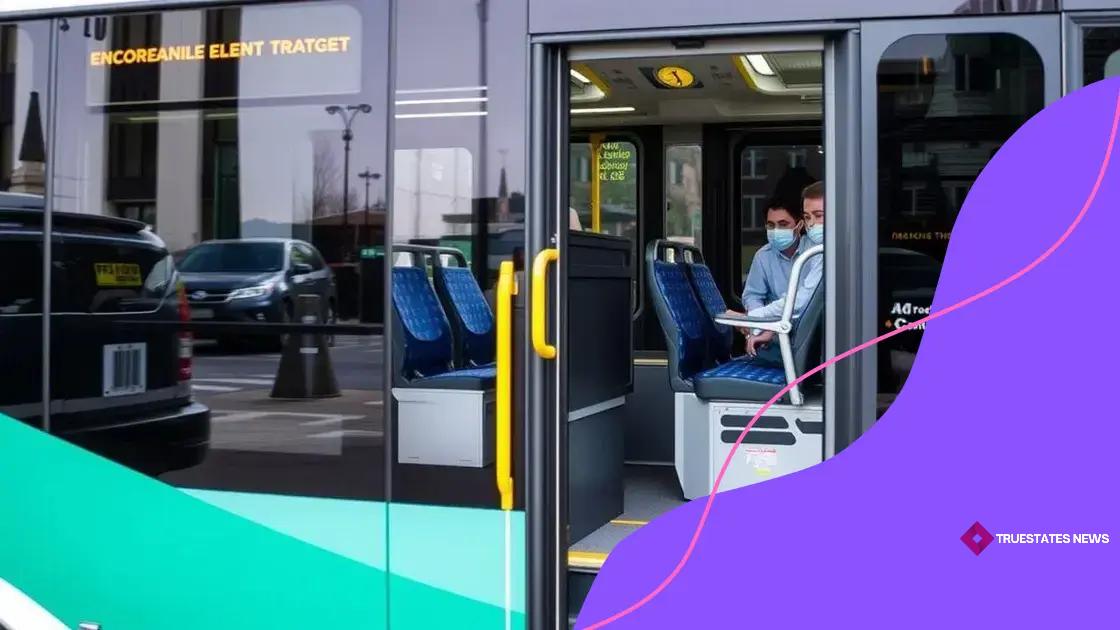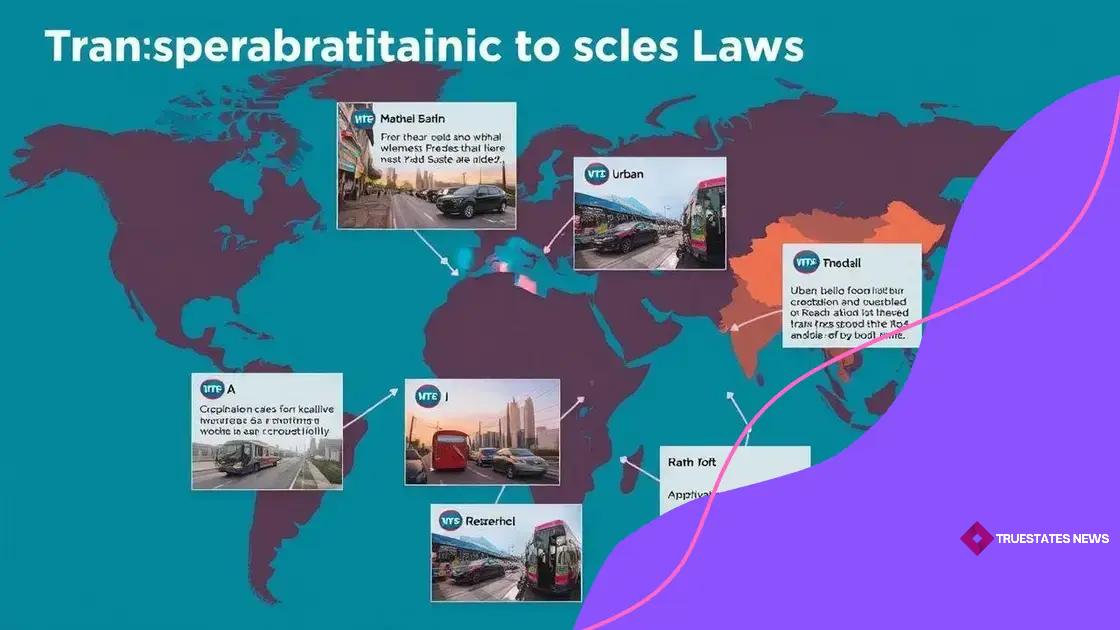Transportation access law: understanding your rights

Transportation access law ensures equal access to public transportation for all individuals, especially those with disabilities, promoting inclusive and equitable transit systems through regulations and advocacy efforts.
Transportation access law plays a vital role in guaranteeing equitable access to public transportation. Have you ever wondered how these laws affect your daily commute? Let’s dive into the details!
The basics of transportation access law
The basics of transportation access law are essential for understanding how public transportation systems operate. These laws are designed to ensure that everyone, including individuals with disabilities, can access transportation services.
In many places, transport laws are influenced by national standards, like the Americans with Disabilities Act (ADA). This legislation has set a benchmark for accessibility, making it important for public transit authorities to comply.
Key Components of Transportation Access Law
Transportation access laws include several critical components:
- Equal Access: All individuals should have the right to access transportation services without discrimination.
- Accessibility Features: Public transport must include features such as ramps, elevators, and designated seating.
- Effective Communication: Transit authorities should provide information in accessible formats.
- Complaint Processes: There should be clear procedures for individuals to report access issues.
Additionally, it’s important to recognize that state and local laws can also enhance these protections. For example, some states have regulations that expand on the ADA, requiring more comprehensive accessibility measures.
Understanding Compliance and Enforcement
Compliance with transportation access laws is monitored by regulatory agencies. These agencies often conduct investigations if complaints arise. Communities play a role as well, advocating for better services and holding transit authorities accountable.
When transit agencies fail to comply, they can face legal challenges. Advocacy groups often step in to support affected individuals and push for necessary changes. Their efforts are crucial in promoting better practices in public transportation.
Overall, knowing the basics of transportation access law helps individuals understand their rights. It empowers them to engage with public transit systems and to challenge barriers they may encounter.
Key rights granted under transportation access laws
Understanding the key rights granted under transportation access laws is crucial for everyone, especially for people with disabilities. These laws provide a framework to ensure fair access to public transportation services, making travel more inclusive.
One of the main rights under these laws is the right to non-discriminatory access. This means that individuals cannot be denied access to transportation services because of their abilities. All public transit systems must provide equal opportunities for all users.
Essential Rights for Travelers
Among the essential rights provided are:
- Accessible Facilities: Public transportation must be equipped with accessible features like ramps and designated seating.
- Safe Travel: Individuals have the right to travel safely without facing harassment or injury.
- Appropriate Assistance: Transit staff must assist individuals who may need help boarding or disembarking.
- Accessible Information: All travel information must be available in formats that are easy to understand for individuals with various needs.
Moreover, there are laws that mandate regular training for transit employees. This ensures that they are aware of the rights of passengers and how to assist them effectively. By fostering a well-informed staff, transit authorities can improve overall accessibility.
Enforcement and Reporting
Another fundamental right is the ability to report violations of access laws. If someone faces discrimination or lack of access, they have the right to file complaints with local agencies or advocacy groups. These processes help keep transit systems accountable for providing proper access.
Public awareness is vital for promoting these rights. Many advocacy groups work tirelessly to inform individuals about their rights and to encourage them to speak up when they encounter issues. By understanding these key rights, users can better navigate transportation systems with confidence and ease.
How transportation access laws vary by region

Transportation access laws can significantly differ from one region to another. Each area may implement its own rules and regulations based on local needs and populations. Understanding these differences is crucial for individuals who rely on transportation services.
In some regions, laws might be more stringent, ensuring comprehensive access for people with disabilities. For example, urban areas may have better resources devoted to public transport accessibility compared to rural regions where services can be limited.
Examples of Regional Variations
Some key variations include:
- Urban vs. Rural: Urban areas often provide more accessible transportation options, while rural areas may struggle with limited public transit services.
- State Regulations: Each state can have different laws that exceed federal requirements, enhancing access.
- Funding Levels: Regions with higher funding may offer better resources and services for accessible transportation.
- Community Advocacy: Areas with strong advocacy groups may compel local governments to improve existing transportation systems and comply with access laws.
Additionally, climatic conditions can influence the effectiveness of transportation access laws. For instance, snowy regions may require additional provisions for snow removal and safe access during winter months. This shows that environmental considerations also play a role in how laws are applied.
Importance of Local Knowledge
It is important for individuals to be aware of their local transportation laws and advocate for necessary changes. Keeping informed about regional variations can empower users to navigate their options effectively.
Further, understanding these differences helps facilitate discussions with local lawmakers and transit authorities. By knowing what is available and what improvements are needed, individuals can take action to enhance accessible transportation in their areas.
The role of advocacy groups in promoting access
The role of advocacy groups in promoting access to transportation is crucial. These organizations work to ensure that everyone, especially those with disabilities, can utilize public transit systems without barriers. They are often the voice for individuals whose needs might not be adequately represented.
Advocacy groups engage in various activities to advance transportation access rights. Their efforts can include raising awareness, providing education, and lobbying for improvements in public transit systems. This multifaceted approach is essential in creating systemic changes.
Key Functions of Advocacy Groups
Some of the key functions they perform include:
- Awareness Campaigns: These groups run campaigns to inform the public about the importance of accessible transportation.
- Legal Support: They often provide legal assistance to individuals facing discrimination or barriers in accessing transportation services.
- Collaboration with Agencies: Advocacy organizations often work closely with transit authorities to ensure compliance with access laws.
- Community Engagement: They engage with the community to gather feedback on transportation needs and advocate for changes based on these insights.
Additionally, these organizations play a key role in monitoring compliance with transportation access laws. They assess whether public transportation providers meet their obligations and hold them accountable if they do not. By tracking issues and reporting findings, they help create a more accessible system.
Impact on Policy Changes
Through their advocacy efforts, these groups influence policy changes at local, state, and national levels. They present data and personal stories to legislators, illustrating the need for better access and support. Their work not only impacts current laws but also shapes future legislation related to transportation access.
As a result, advocacy groups are integral to promoting equitable transportation solutions. By continuing to push for change, they contribute significantly to creating inclusive communities where everyone can travel freely.
Future trends in transportation access law
Future trends in transportation access law indicate a shift towards greater inclusivity and technology integration. As society becomes more aware of the importance of accessible transportation, laws are evolving to meet modern needs.
One significant trend is the emphasis on universal design. This approach goes beyond just meeting minimum legal requirements. It focuses on creating transportation systems that are inherently accessible to everyone, regardless of their abilities. This means designing transit systems from the ground up with accessibility in mind.
Technological Innovations
Technological advancements are also shaping the future of transportation access. Tools such as:
- Mobile Apps: Many public transit systems are developing apps that provide real-time information on accessibility features.
- Smart Transit Solutions: Innovations like on-demand transit services can offer more flexible and accessible options for individuals with disabilities.
- Automated Vehicles: The development of self-driving cars could revolutionize transportation for those unable to drive, providing new independence.
- AI and Machine Learning: These technologies can assist transit agencies in identifying barriers and improving services based on user feedback.
Moreover, there is a growing awareness of the need for environmentally friendly transportation options. Future transportation laws may incorporate sustainability standards, ensuring that new accessible transit options also align with eco-friendly practices.
Policy Changes and Advocacy
Additionally, advocacy efforts are likely to increase in strength and visibility. Groups dedicated to promoting access will push for new legislation that highlights the rights of individuals with disabilities and emphasizes their needs in all aspects of transportation planning.
Overall, the future of transportation access law is geared towards greater collaboration between government bodies, tech companies, and advocacy groups. This inclusive approach is expected to create a more equitable transportation landscape for everyone.
The future of transportation access law is bright, with promising trends pointing towards enhanced inclusivity and the incorporation of technology. By prioritizing universal design and leveraging innovations, we can expect a more accessible and equitable transportation landscape. Advocacy groups play a crucial role in this transformation, pushing for necessary changes and ensuring that every individual’s needs are met. As we move forward, collaboration among government agencies, technology developers, and advocacy organizations will be key to creating transportation systems that work for everyone.
Here’s a summary of key points regarding the future of transportation access law:
FAQ – Frequently Asked Questions about Transportation Access Law
What is transportation access law?
Transportation access law ensures that all individuals, especially those with disabilities, can access public transportation services without discrimination.
How do advocacy groups influence transportation access laws?
Advocacy groups raise awareness, provide legal support, and lobby for improvements to ensure that transportation systems meet the needs of all users.
What are some future trends in transportation access law?
Future trends include universal design principles, increased technology integration, and greater emphasis on sustainable transportation options.
How can individuals report violations of transportation access laws?
Individuals can report violations by contacting local transit authorities, advocacy groups, or filing a complaint with relevant regulatory agencies.
